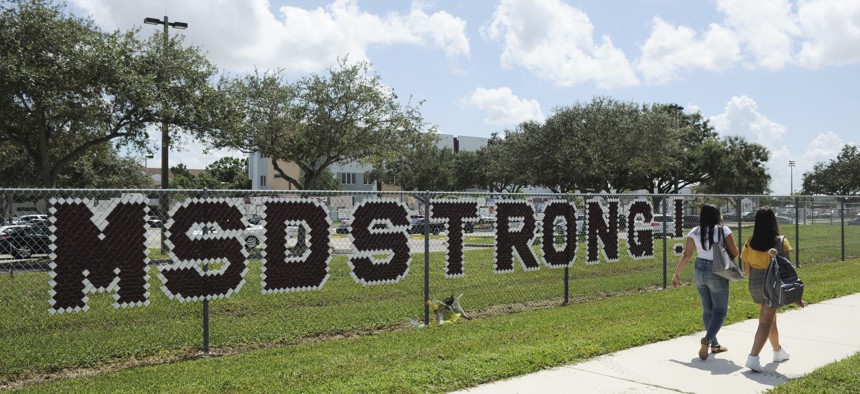Privacy advocates tend to warn that this kind of heightened surveillance can lead to overzealous punishments for minor infractions, or have a chilling effect on students when they know they’re being watched. But the balancing act between privacy and surveillance holds a different meaning in a community still trying to understand the mechanisms that failed it and its children.
The report details the miscommunications, unaddressed safety-code violations, and uncontrollable panic that contributed to the death toll when Nikolas Cruz, a former MSDHS student, brought a gun to the school last February. A faulty fire alarm sent students into the hallways while Cruz was still in the building. The lack of a functioning PA system made it impossible to direct students to safety once they began to flee. SWAT members on the scene mistook video footage of Cruz as live; in fact, it was played with a 26-minute delay.
The Broward County School Board has now given law enforcement real-time access to surveillance video, according to one member of the board, Lori Alhadeff. She ran for and was elected to the school board after her daughter, Alyssa, was killed during the shooting. “These shootings, they happen in six minutes or less,” she told me. “Time equals life. The seconds matter.”
Granting real-time video access to police is only part of a top-to-bottom overhaul of surveillance within Broward County’s schools. With funding from a Department of Justice grant, MSDHS has signed a $621,000 contract with Avigilon, a Vancouver-based video-surveillance company that promises “the future of protection through innovative high-definition surveillance solutions.” Avigilon software analyzes real-time footage using “appearance search” technology, which lets users highlight a person of interest in surveillance-camera video and then scans the footage for all of the instances when the individual appears, making inferences based on clothing and body shape. Florida’s Sun Sentinel reports that 116 cameras equipped with the software are planned for 36 schools in the district.
The report also recommends that the school district “create a centralized ‘data repository’ and analytics resources to improve access to information from sources including social media, the Department of Children and Families, the Department of Law Enforcement, the Department of Juvenile Justice and local law enforcement agencies.” In addition to information about whether students have been sentenced to juvenile detention and if guidance counselors have flagged their behavior, the report recommends a tool that “will scan social media to identify signs of bullying, self-harm, or threats of violence against students, employees, and schools.” The proposed database would be operated by the Office of Safe Schools, a division of the Florida Department of Education.
The “misunderstanding and overapplication of privacy laws,” the report argues, contributed to school officials and the FBI failing to act on the red flags on Cruz’s record, among them: photos of guns posted to his Instagram in the weeks before the shooting, prior medical treatment for severe behavioral issues, and viewing a series of YouTube videos titled “I put spongebob music over a school shooting.”
Cruz’s case is exceptional, and privacy scholars caution that at the scale of hundreds of students, differentiating between online behavior that is troubling or immature and actions that are criminally threatening isn’t easy. Amelia Vance, the director of education privacy and policy at the Future of Privacy Forum, told me that besides privacy concerns, enhanced social-media monitoring misses the point.
“An interesting aspect of the Florida case is that those signs were seen and they were reported; they just weren’t acted on. And so to act as though more monitoring is the answer seems an odd solution,” she said. Vance provided public comment on the Department of Education’s federal report on school safety, which also called for social-media monitoring and enhanced data collection. Both the federal report and the one by MSDHS’s school-safety commission call for easing FERPA and HIPAA laws, which restrict access to private student data.
“This is significant, new data collection that could create the literal permanent record of students doing stupid things online without any sorts of protections on how long that’s kept and who can access it,” Vance said.
But Parkland’s parents told me they’re more concerned about doing anything they can to prevent another mass shooting than with unintended consequences. Max Schachter’s son, Alex, was killed during the shooting. Schachter is part of the group of parents and officials that coordinated the Department of Justice grant application, but he says camera surveillance alone, though essential to a coordinated police response, won’t save lives.
“Are cameras going to prevent a murderer from walking on campus with an AR-15? Of course not,” he said. To him, the proposals don’t go far enough. “I am certainly in favor of advanced camera systems, but I doubt the systems are in place to be able to utilize an advanced camera system in Broward County,” Schachter said. “If you don’t have the right people, train the right staff, and a crime center and [safety] procedures in place, you basically have $600,000 worth of cameras that are basically just gonna be forensics to identify dead bodies.”
Alhadeff explained that since the shooting, she and other school-board members have been working to implement recommendations from varying sources: the commission’s report, along with a risk-assessment report from Safe Haven, a security company, and federal reports from the FBI and the Department of Education. Proposed changes include a new PA system, fire alarms, panic buttons, apps to report anonymous tips, and additional training for teachers and staff.
“It’s not a Happy Meal package,” Aldaheff said. “People think you get your cameras and you’re ready to go, you’re safe. It’s our job to implement all these strategies, but we’re up for the job.”






